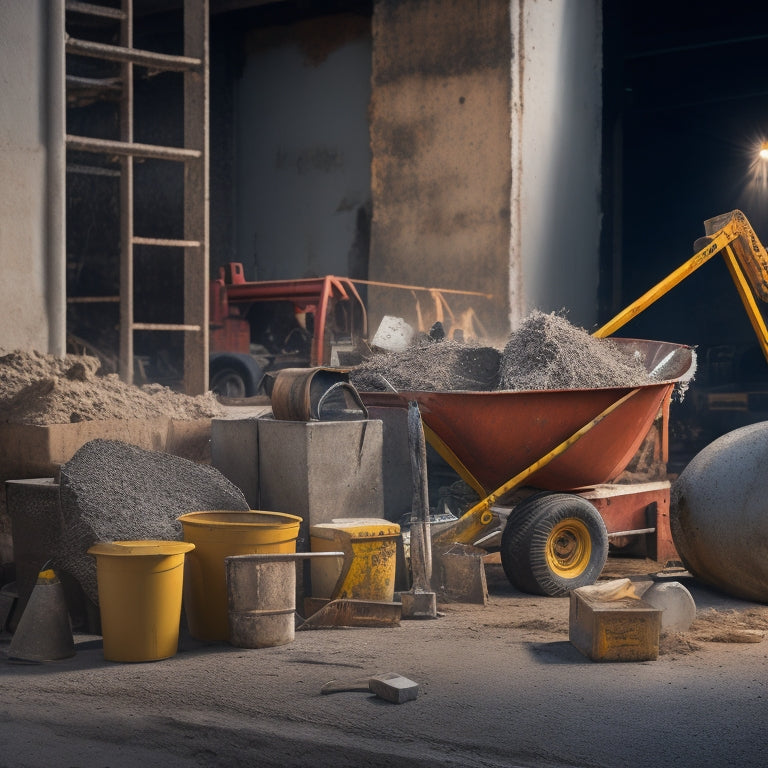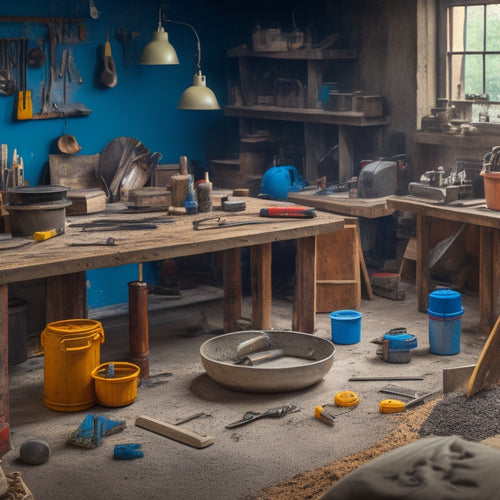
What Tools Do You Need for Concrete Mixing
Share
You'll need a range of essential tools to guarantee a successful concrete mixing process. Start with a concrete mixer, additives, and supplementary materials for uniform consistency. Must-have hand tools include a mixing stick, bucket, level, and curved stick. Don't forget safety gear like protective eyewear, gloves, and a respirator. Measuring and testing tools, such as a scale, slump cone, and pH meter, will guarantee accurate ratios and consistency. From power tools like electric mixers to specialized finishing tools like trowels and floats, every tool plays a critical role. With the right tools, you'll be well on your way to achieving a strong and durable concrete mixture.
Key Takeaways
• Essential tools for concrete mixing include a concrete mixer, mixing stick, and measuring tools to ensure uniform consistency and accurate ratios.
• Safety gear such as protective eyewear, gloves, and respiratory masks are crucial to mitigate health risks associated with concrete work.
• A mixing bucket, whether steel, poly, or fiberglass, is necessary for mixing and transporting concrete, with regular maintenance extending its lifespan.
• Power tools like electric mixers and drill-mixer combos can handle large batches and improve mixing efficiency, while variable speed controls allow for customized mixing processes.
• Specialized tools like trowels, floats, and darbies are necessary for achieving a smooth finish and desired texture in the final concrete product.
Essential Concrete Mixing Equipment
You'll need a concrete mixer, also known as a cement mixer, to combine cement, aggregate, and water into a uniform consistency. This essential equipment guarantees that your concrete mixture is well-blended, which is critical for achieving the desired strength and durability of the final product.
When selecting a concrete mixer, take into account the size of your project and the type of mixing techniques you'll be using. For example, a drum mixer is suitable for large-scale projects, while a pan mixer is better suited for smaller batches.
To enhance the performance of your concrete mixture, you may also want to think about adding concrete additives. These can include admixtures, such as air-entraining agents or retarding agents, which can improve the workability, strength, and durability of your concrete.
Additionally, you may want to use supplementary cementitious materials, like fly ash or silica fume, to reduce the amount of cement required and improve the sustainability of your mixture.
Must-Have Hand Tools for Mixing
As you prepare to mix concrete, having the right hand tools on hand is vital to secure a smooth, efficient, and accurate process.
You'll need a sturdy mixing stick or tamping tool to scrape the sides and bottom of the mixing container, making sure all ingredients are well incorporated. A mixing bucket or wheelbarrow is also a must-have, as it provides a clean and convenient surface for mixing. Additionally, a level and a screed or strike-off tool will help you achieve a smooth, even finish.
When it comes to mixing techniques, having the right hand tools can make all the difference. For instance, a mixing stick with a curved end can help you reach into corners and crevices, while a flat-edged stick is better suited for scraping the sides of the bucket.
Regular tool maintenance is also essential, as it makes certain your tools remain in good condition and continue to perform at their best.
Safety Gear for Concrete Work
Wearing the right safety gear is essential when working with concrete, as it protects you from the harsh chemicals and physical hazards inherent in the process. Concrete mixing involves dealing with alkaline substances, silica dust, and other hazardous materials that can cause serious health issues if not handled properly. You need to prioritize your safety above all else.
When it comes to eye protection, you'll need protective eyewear that meets the ANSI Z87.1 standard. Look for goggles or safety glasses with polycarbonate lenses that provide excellent impact resistance.
You should also invest in a good pair of gloves that offer grip, dexterity, and cut resistance. Don't forget to wear long sleeves, pants, and closed-toe shoes to prevent skin contact and abrasion.
Respiratory protection is equally significant. You'll need respiratory masks with a HEPA filter or a NIOSH-approved respirator to prevent inhalation of silica dust and other airborne contaminants. Make sure to choose a mask that fits snugly and provides a good seal around your face.
Measuring and Testing Tools
To guarantee accurate concrete mix ratios and detect potential issues, you need to equip yourself with the right measuring and testing tools. Mixing concrete is a precise process, and small variations in ratios can greatly impact the final product's strength and durability.
Here are some essential measuring and testing tools you'll need:
-
Scale or Batching Scale: Accurately measure cement, sand, and aggregate quantities to maintain the correct mixing ratios.
-
Slump Cone: Conduct a slump test to evaluate the concrete's workability and consistency, ensuring it meets the required test methods.
-
pH Meter: Test the concrete's pH level to detect potential issues with the mix, such as excessive alkalinity or acidity.
Concrete Mixing Bucket Essentials
Your concrete mixing bucket is the heart of your mixing operation, and it's vital to outfit it with the right accessories to guarantee efficient and effective mixing. When it comes to choosing a mixing bucket, you have several options, including steel, poly, and fiberglass buckets. Each type has its own advantages and disadvantages, which are summarized in the table below:
| Mixing Bucket Type | Advantages | Disadvantages |
|---|---|---|
| Steel | Durable, cost-effective | Heavy, prone to rust |
| Poly | Lightweight, resistant to corrosion | May crack under heavy use |
| Fiberglass | Lightweight, resistant to corrosion | May be more expensive |
| Bucket Liner | Easy cleanup, prevents rust | Adds extra cost |
| Bucket Screed | Improves mixing efficiency | Requires additional effort |
In addition to choosing the right bucket, regular maintenance is essential to guarantee peak performance. Some bucket maintenance tips include cleaning the bucket after each use, applying a rust inhibitor to steel buckets, and storing the bucket in a dry location. By following these tips and selecting the right accessories, you can ensure your mixing bucket operates at peak efficiency and extends its lifespan.
Power Tools for Efficient Mixing
You'll need to complement your well-maintained mixing bucket with the right power tools to achieve efficient mixing and consistent results. Electric mixers are a must-have for any serious concrete mixing operation. These powerful tools can handle heavy loads and are designed to withstand the rigors of frequent use.
Here are three essential power tools you'll need for efficient mixing:
-
Electric Mixers: These are the workhorses of concrete mixing, capable of handling large batches of concrete with ease. Look for mixers with variable speed controls and heavy-duty motors.
-
Mixing Paddles: These attachments are designed to work in conjunction with your electric mixer, providing a more efficient and thorough mixing action. They come in a range of sizes and styles to suit different mixing tasks.
-
Drill-Mixer Combos: These versatile tools combine the power of a drill with the functionality of a mixer, making them ideal for smaller mixing tasks or when working in tight spaces.
Specialized Tools for Finishing
With the mixing process complete, specialized tools for finishing come into play, enabling you to achieve a smooth, even surface and precise control over the final product.
Now it's time to focus on the finer details, and that's where trowels come in. You'll need a range of trowels in various sizes and shapes to master different trowel techniques. A finishing trowel, for instance, is designed for applying the final layer of concrete and achieving a smooth finish. An edger trowel, on the other hand, is used to create clean edges and corners.
To add the finishing touches, you may also require a float or a darby. These tools help to remove excess water, flatten the surface, and create a uniform texture.
When choosing your finishing tools, consider the type of concrete you're working with, as well as the desired finish. With the right tools and techniques, you'll be able to achieve a professional-looking finish that meets your high standards.
Frequently Asked Questions
How Often Should I Clean My Concrete Mixing Tools?
You should establish a regular cleaning schedule for your concrete mixing tools to prevent material buildup and guarantee peak performance.
A daily cleaning routine is ideal, but at a minimum, clean your tools every 3-4 uses.
This maintenance habit will reduce wear and tear, prevent corrosion, and make future cleaning tasks easier.
Can I Use a Drill With a Concrete Mixing Paddle?
Don't worry, you're not stuck with a manual mixing process.
To efficiently mix concrete, you can use a drill with a concrete mixing paddle, but it's essential to guarantee your drill meets the specifications.
Look for a drill with a high torque output (at least 500 in-lbs) and a slow speed setting (around 500-600 RPM).
Also, verify the paddle's compatibility with your drill's chuck size and type.
With the right combo, you'll achieve a smooth, consistent mix.
Are There Any Environmentally Friendly Concrete Mixes Available?
You'll be pleased to know that yes, there are environmentally friendly concrete mixes available.
When shopping for sustainable materials, look for mixes that incorporate eco-friendly additives like fly ash, slag, or recycled aggregates.
These alternatives reduce the carbon footprint of traditional cement-based concretes.
Some mixes even utilize supplementary cementitious materials, further minimizing environmental impact.
Can I Mix Concrete in a Plastic Bucket?
You're wondering if a plastic bucket is suitable for mixing concrete. The answer is yes, but consider the bucket's capacity and your mixing techniques.
A bucket with a capacity of at least 5 gallons is recommended.
When mixing, use a sturdy mixing stick or trowel to scrape the sides and bottom of the bucket, ensuring all ingredients are well incorporated.
Avoid overmixing, as this can lead to a weak or uneven concrete consistency.
How Do I Properly Store Leftover Mixed Concrete?
You're left holding a ticking time bomb - leftover mixed concrete that's rapidly hardening.
To defuse the situation, you'll need a solid storage plan. For concrete mix preservation, seal the leftover concrete in an airtight container or plastic bag, removing as much air as possible.
Store it in a cool, dry place, protected from direct sunlight and moisture. This will slow down the hardening process, giving you a window to reuse it or dispose of it properly.
Conclusion
You've got the right tools for concrete mixing, but did you know that the global concrete market is projected to reach $633.4 billion by 2025?
With the right equipment, you'll be well-equipped to tap into this growing industry.
Remember, investing in quality tools is essential for efficient, safe, and high-quality concrete mixing.
By following this guide, you'll be able to tackle any concrete project that comes your way.
Related Posts
-

Why You Need Affordable Concrete Wall Construction Tools
You need affordable concrete wall construction tools to guarantee a profitable project, as the cost of equipment can ...
-

Budget-Friendly Tools for DIY Decorative Concrete Profiling
You can achieve professional-grade decorative concrete results on a budget by investing in the right combination of e...
-

What Tools Are Needed for Concrete Wall Foundations
You'll need a thorough array of tools and equipment to construct a concrete wall foundation that meets structural int...


